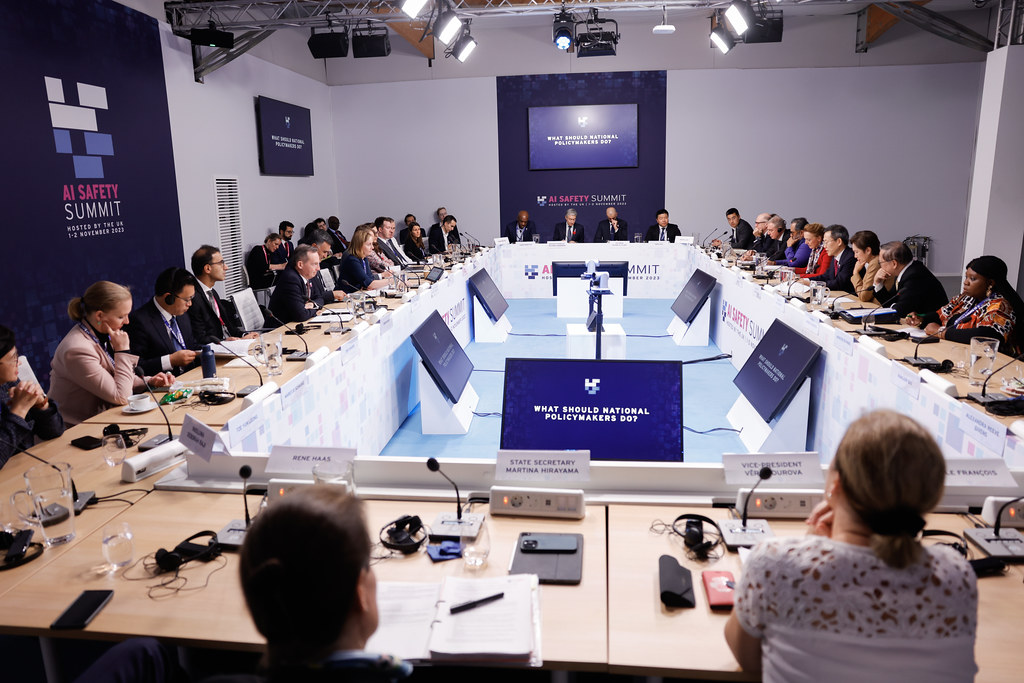Challenger and Incumbent Tools for U.S.-China Tech Competition
America’s competition strategy has not yet adapted to China’s technological prowess.
d0a4ce67-0e26-4124-abec-981129d0f139.jpeg?sfvrsn=bfa64ef7_6)
Published by The Lawfare Institute
in Cooperation With

On Jan. 20, Chinese company DeepSeek released its R1 model, defying American dominance of AI. The model, which was built through software optimization rather than expensive microchip investments, beats leading competitors like OpenAI in several metrics and costs a tiny fraction of their development expenditure. The model’s innovative approach spooked microchip investors, prompting the largest single-day market cap loss in U.S. history for Nvidia.
DeepSeek is a harbinger of things to come. Regardless of which country takes the lead in AI, China will deploy its ample resources to lead the world in some, if not many, technological domains.
The nascent U.S. approach to technological competition with China consists of laws and institutions that rely on American dominance—incumbent tools. Financial sanctions depend on the hegemony of the dollar and of Western financial intermediaries. Export controls are designed to prevent U.S. technology that is not available elsewhere from reaching the wrong hands. The Committee on Foreign Investment in the United States (CFIUS) enables the government to block foreign direct investments into the United States that might compromise national security, including those that could lead an adversary to acquire sensitive technology. The recent Treasury Department rule on outbound investments restricts certain transactions between U.S. and foreign entities in order to prevent U.S. companies from helping rival countries by facilitating financing, know-how, or access to talent. Each incumbent tool of economic national security is designed to prevent foreign (usually Chinese) access to American assets (usually technology) with unique capabilities.
These incumbent tools are well suited for judicious use in the technological domains where the U.S. is dominant. Investing in innovation, research and development, and other activities can also help maintain America’s edge in those domains. But incumbent tools are ineffective, or even counterproductive, in technologies where multiple countries are at the innovative frontier, or where China is the leader.
The United States’s inchoate economic national security strategy takes American technological primacy for granted, expanding and strengthening tools that shield U.S. technology from Chinese acquisition. This is the approach of a technological incumbent. In the sectors where China is in the lead, however, effective strategy would deploy the tools of a challenger that facilitate the acquisition of Chinese technology by U.S. firms. These tools, employed by China itself in its efforts to catch up with the U.S., range from translating basic research to requiring joint ventures and technology transfer for access to domestic markets.
The Current Landscape
China will inevitably match or exceed U.S. capabilities in some technologies. With a population four times the size of the United States, China could engage four times as many research scientists and technologists without affecting its capacity for manufacturing, warfighting, or other endeavors. In fact, China awarded seven times as many engineering degrees as American universities did in 2020 and is expected to produce twice as many STEM doctorates as the U.S. by 2025. The Chinese government has been funneling money into technological innovation since 2006, and this intense focus has yielded results. China files twice as many patents as the U.S., and the top 1 percent most-cited scientific publications feature more Chinese than American research.
China’s technological prowess has developed unequally across different sectors, however, creating a checkerboard of primacy—one country leads in some domains, while adjacent domains may be led by others. For instance, one recent analysis concluded that the U.S. leads in quantum computing, China is ahead in quantum communication, and they are peers in quantum sensing. While the U.S. is ahead in AI chip design, China has a clear edge in batteries, photovoltaics, and other green technology. In fields as complex as biotechnology, there is often no clear leader and the current “incumbent” changes based on the subfield and the metrics used to define incumbency.
Winning strategies start by evaluating the gamespace. The appropriate tactics depend on whether the acting country is the incumbent or the challenger in the relevant domain. Playing like the favorite while being the underdog is a recipe for failure, like a basketball team running out the clock when they’re down two points with seconds to go.
The fundamental premise of both incumbent and challenger tools used in economic competition, from CFIUS to outbound investment controls, is that greater linkages favor the challenger. Full disclosure of every beverage company’s recipe would favor RC Cola, not Coca Cola. Thus, limiting China’s access to U.S. GPU design technology favors the U.S., but limiting U.S. companies’ access to Chinese photovoltaic technology would favor China. The rule of thumb is that countries should build walls where they’re winning and build bridges where they need to catch up.
Deploying Challenger Tactics
American competition strategy will be more effective if it adopts challenger tactics in sectors where China is the incumbent. Countries like Japan and China have developed a sophisticated playbook of challenger tools that enable the transfer of expertise and technology from incumbent countries to domestic actors. The U.S. could adopt some of these approaches, with adjustments.
Although the U.S. may be a challenger in, say, electric car batteries, its general dominance in economic, military, and diplomatic theaters would render some tactics used by other, less dominant countries ineffective. Similarly, techniques that undermine the rule of law, like hacking, would be inconsistent with broader American geopolitical strategy. The U.S. also lacks a state-centered mechanism for spreading intellectual property across private actors. While the Chinese government may disseminate foreign-acquired technology among Chinese firms, a U.S. firm that acquires a new technology is likely to keep it proprietary to maximize its private value.
Perhaps the most common mechanism to facilitate technology transfer is the regulation of transactions. Joint ventures, purchasing or licensing technology, and investing in foreign firms with desirable technological capabilities have been used to transfer knowledge and techniques from incumbent countries to challengers across the globe. For a market economy like the U.S., private companies will already pursue many of these strategies if they are profitable. However, there are still several ways the government can encourage transactions or deal terms that promote technology transfer.
The most straightforward approaches leverage a country’s domestic market access to extract technological information through joint venture and localization requirements. China requires foreign companies to establish joint ventures with domestic firms in order to operate in certain industries, like car manufacturing and aviation. It specifically requires foreign partners to provide intellectual property and technology to their local counterparts, which has successfully resulted in many of Chinese companies’ most innovative techniques and products. Similarly, Japan was able to threaten U.S. semiconductor dominance in the 1980s because it required IBM and Texas Instruments to share technology with Japanese companies in order to sell products in Japan and repatriate their profits. The U.S. might consider similarly requiring joint ventures with technology sharing requirements for Chinese companies operating in particular sectors.
Local content requirements induce foreign firms to manufacture critical products on domestic soil. These can either work in tandem with a joint venture requirement or independently increase the likelihood of local technology diffusion. While local content requirements risk violating World Trade Organization (WTO) treaties, they are commonly used and are not often contested at the WTO.
More tenuously, the U.S. could attempt to incentivize outbound foreign investment in critical sectors. While China appears to use more explicit (if undisclosed) state direction to induce private Chinese investment in U.S. companies involved in key industries, the U.S. would need a less coercive approach. For example, the federal government could offer tax breaks for U.S. firms that acquire sufficiently large stakes in Chinese firms in a particular sector. That might increase the number of acquisitions by U.S. entities of Chinese intellectual property in priority industries.
The U.S. government could also sponsor English translations of Chinese scientific publications for use by domestic researchers. China is in the midst of a significant effort to domesticize scientific research publishing, launching a massive journal funding effort called the “China Journal Excellence Action Plan” and factoring domestic publishing into academic promotion decisions. Only about 12 percent of China’s 5,000 academic journals are available in English. While much of that research is not of especially high quality, that is likely to change as total Chinese output continues to outpace the U.S. and its efforts at domesticization yield results. It is notable that China made its own early effort to collect millions of open-source foreign conference papers for centralized access by Chinese researchers.
Perhaps the most controversial challenger tool, deployed by China at scale, is cyber espionage. A 2018 analysis estimated that Chinese theft of private U.S. intellectual property cost the American economy $20–$30 billion annually. There have been some proposals to allow U.S. companies to retaliate with their own hacking, through privateering-style letters of marque or other legal innovations. However, the U.S. has taken a principled stand in international negotiations that it will not engage in cyber espionage of foreign companies to benefit domestic firms, as part of its attempt to set international norms that other countries will follow. While some find the possibility of retaliation for decades of Chinese intellectual property theft appealing, pursuing such a course would undermine broader American diplomatic initiatives.
***
Admittedly, it can be difficult to deploy challenger and incumbent tools simultaneously. Incumbent tools like sanctions and export controls risk deterring domestic companies from engaging in transactions that would precipitate technology transfer. As sanctions, investment, and export control regimes grow more numerous and complex, many companies choose to “de-risk” or “overcomply” by pulling out of a country or sector entirely rather than bear compliance costs and the risk of penalty if they violate a restriction. Overly vigorous efforts to maintain an American lead in one sector could prevent the U.S. from catching up to China in another. Similarly, efforts to develop deep links between domestic and foreign firms to enable technology transfer in one critical sector might facilitate unintended reverse transfers in other sectors.
Each of the challenger tools also poses risks. Joint ventures and local content requirements could accelerate the degradation of a free global market. China could block any transactions that a U.S. tax break incentivizes. Translating Chinese research could erode U.S. journals’ supremacy. Cyberespionage could spark widespread and deleterious state-sanctioned cybercrime.
Of course, the incumbent tools pose similar risks; each tool comes with trade-offs to its use.
The Trump administration has signaled it will reevaluate U.S. strategy from the past four years, from AI to trade, with the goal of establishing American dominance. This evaluation is an opportunity to identify where China is the incumbent and to diversify the toolkit of U.S. responses, for use now and later. No matter how aggressively the U.S. deploys incumbent tactics, China will produce many more DeepSeeks in different domains. Eventually, American strategy will have to adopt challenger tools to respond effectively.





